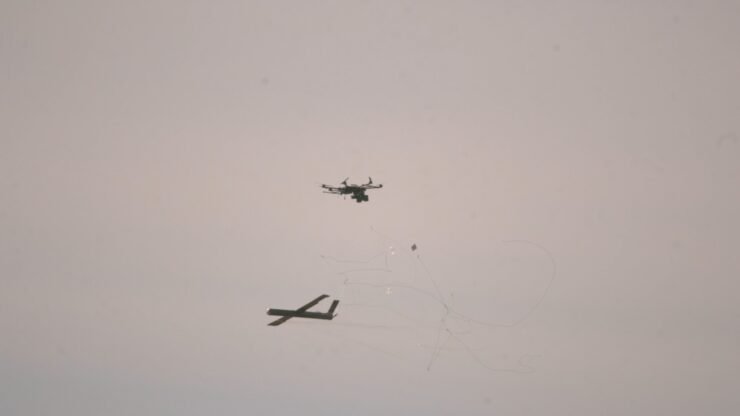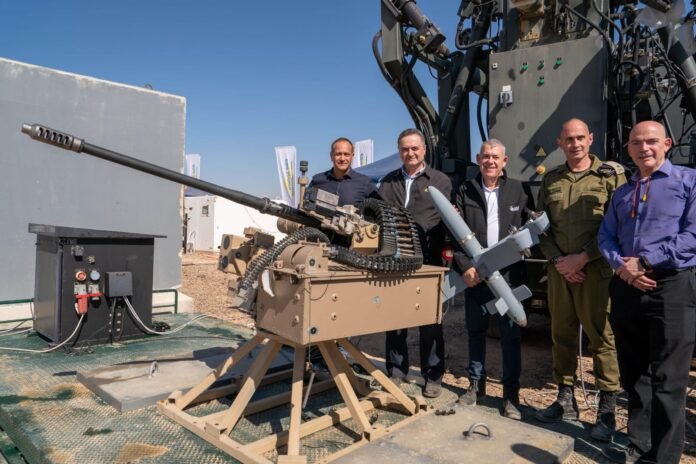Tel Aviv: The Israel Ministry of Defence (IMOD) Directorate of Defence Research & Development (DDR&D) has successfully completed an extensive series of operational trials testing approximately 20 advanced counter-drone technologies. Nine Israeli defence industries and startups demonstrated various drone interception and neutralisation capabilities using both projectile-based systems and counter-drones at a testing field in southern Israel on February 4, 2025.
Defence Minister, Israel Katz; IMOD Deputy Director General and Head of the Planning Department, Itamar Graff; Head of the DDR&D, Brig Gen (Ret.) Dr Daniel Gold; IDF Head of Planning and Force Build-Up Directorate, Maj Gen Eyal Harel; and other senior officials led the concluding demonstrations. This follows the initial series of trials conducted in October 2024, initiated under the directive of IMOD Director General, Maj Gen (Res.) Eyal Zamir, to conduct an accelerated competitive process for finding interception solutions to address current challenges.
The trials featured major defence contractors, including Elbit Systems, Rafael, and Israel Aerospace Industries, alongside several startups, showcasing their progress in developing technological solutions for drone interception. As part of the competition, the industries deployed interception system prototypes developed under DDR&D leadership, demonstrating drone interception capabilities at various ranges, speeds, and altitudes.
Following the analysis of current trial results, the IMOD plans to select several technologies for accelerated development and production processes, aiming to deploy new operational capabilities immediately. Industry CEOs also attended the trials alongside senior IDF and Ministry officials.
Additionally, this trial is one of several initiatives through which the DDR&D is tackling the growing C-UAS threat. In partnership with the US Department of Defense (DoD) – Irregular Warfare Technical Support Directorate (IWTSD), the DDR&D is developing cutting-edge technologies for detecting and neutralising UAS that endanger both nations. With more than twenty US C-UAS experts from across the DoD participating in the blind test, this event plays a critical role in fostering cooperation between the nations, rapidly enhancing joint defence capabilities, and improving the chances of success. Recognising this, Congress has reinforced the partnership to advance cooperative research and development efforts, further strengthening the shared commitment to countering this evolving threat.
Defence Minister, Israel Katz said, “The UAV threat is an evolving and multi-arena threat that has expanded to all our combat sectors, led by Iran and its proxies. This threat has already extracted a heavy human toll from us, which is why we have mobilised all tools to develop an effective response. The series of tests we conducted represents a national effort led by the DDR&D, with participation from major defence companies alongside innovative startups.”
Brig Gen (Ret.) Dr Daniel Gold, Head of the DDR&D commented, “The defence establishment is determined to complete a comprehensive defensive response to the drone threat, as we have done for threats in the upper layers. We have defined an operational architecture with the IDF, including detection, tracking, and interception layers. In this series of follow-up trials, we witnessed the advancement of sophisticated drone interception capabilities, which will now enter an accelerated development process under DDR&D leadership.”

IDF Head of Planning and Force Build-Up Directorate, Maj Gen Eyal Harel remarked, “We are in a learning competition with the enemy, particularly in the field of UAVs, which challenges us across multiple combat zones. Throughout the war, we have developed various creative, technological, and operational solutions that have led to unprecedented achievements on the battlefield. This day has demonstrated the importance of continued technological efforts that showcase Israel’s existing technological capabilities. The synergy between the defence establishment and Israel’s technological sector serves as a force multiplier, enabling us to provide comprehensive protection for Israel’s airspace and our forces on the ground. In the coming months, we will select the most suitable capabilities and implement them extensively throughout the IDF. Much appreciation to the participating industries.”
Participating Companies and their Developments:
- -Elbit Systems demonstrated an advanced radar-based interception system with interceptor drones, a hard-kill drone-based defence system against missiles and drones, and an integrated 30mm cannon with radar enabling long-range detection and interception.
- Israel Aerospace Industries (IAI) presented the C-UAS development, an autonomous spatial system for handling UAV threats based on SOI. The solution includes a sensor array and distributed interception systems, including an advanced technology concept electric missile for long range, a short-range drone interceptor, and a 30mm cannon.
- Rafael Advanced Defense Systems showcased the Mini Typhoon, a remote-controlled medium-range weapon system for aerial threat interception, alongside innovative drone-based interception systems.
- Airobotics demonstrated an advanced system featuring reusable interceptors for UAV engagement.
- Tamar Group is repurposing automatic rapid-fire projectile weapon systems that were taken out of service and converting them into systems capable of UAV interception.
- Xtend, in cooperation with Axioma and Elbit Systems, demonstrated an advanced drone-based interception system.
- General Robotics showcased a development for projectile interception at medium ranges, plus an innovative advanced machine gun-based solution.
- Smart Shooter presented a unique development enabling precise guidance for a wide range of interception methods.
- Robotican demonstrated two advanced multi-purpose drone interception systems.
- Elisra, a member of Elbit Systems, in cooperation with an American company, presented a net-based interceptor drone.
-The writer is an Israel-based freelance journalist. The views expressed are of the writer and do not necessarily reflect the views of Raksha Anirveda






